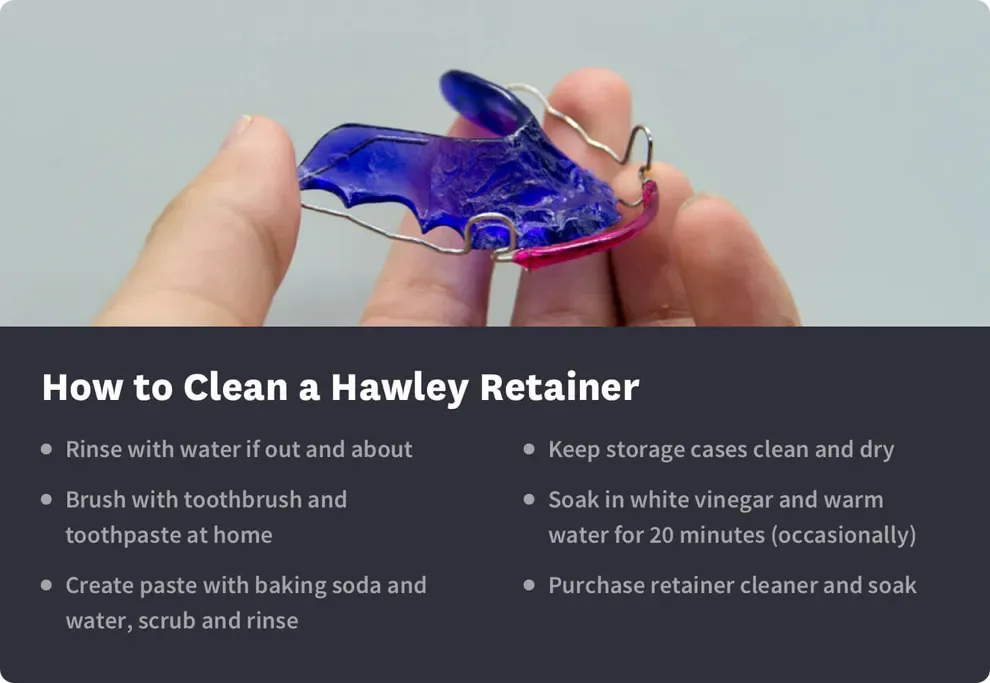Hawley Retainers: Cost, Cleaning & Alternatives

Table of Contents
- Uses
- Cost
- Cleaning
- Alternatives
- Finding the Best Retainer
- References
Hawley retainers are some of the more affordable retainers available, and they are very durable. They range in price from $300 to $600 for a set.
If you want a less visible retainer, they may not be the best type of retainer for your needs. Essix retainers are alternative options.
Hawley Retainers: The Classic End of Orthodontics Treatment
When you imagine a retainer, you probably imagine a Hawley retainer: a device made from wire that goes around the front of your teeth, with an acrylic piece that holds the wires in place. This orthodontic device is typically prescribed after treatment with braces or clear plastic aligners, but in some cases, the Hawley retainer can be modified for use as the main orthodontic device in treatment.
Retainers like the Hawley style are designed to keep your teeth in place after orthodontic treatment because as your teeth move, they may lose a certain amount of bone mass that needs to regrow. If there is no support from a retainer, your teeth are more likely to shift faster.
While your teeth may shift again over the next several years, following proper retainer guidelines after treatment helps them stay in place longer.
How Much Do Hawley Retainers Cost?
If your orthodontist determines that you need a retainer, this is typically covered in the overall cost of treatment.
As adult orthodontics become more popular, more dental plans offer some coverage for people over the age of 18; however, this typically will only include up to about half the cost of orthodontic treatment, at most. This coverage is likely to cover some of the cost of your retainers after treatment, but if you break or lose the retainer, you will pay for the replacement entirely out of pocket.
The reported cost of one Hawley retainer is between $150 and $300, and a set ranges from $300 to $600. This is the reported cost before insurance.
Hawley retainers are sturdy compared to other types, like the fully acrylic or plastic retainers, so replacements are less of a concern. It is still important to take care of your retainers, so they are clean and in good shape.
Replacing a Hawley retainer may cost between $70 and $250 for one or up to $500 to replace the set.
How Should I Keep My Hawley Retainer Clean?
Keeping your retainer in a clean box or bag that you leave in the same place is the best way to avoid losing the retainer or damaging it. Retainers often come with holding cases, but if you are not satisfied with the case provided, the American Association of Orthodontists (AAO) recommends getting a clean bag or a different type of retainer case.
Retainer cases are better at protecting your retainer if you need to remove it or carry it with you. The AAO recommends:
Carry an extra case with you, so you can safely store your retainer in a clean place.
Avoid putting your retainer in a pocket or purse, which could damage the device.
Do not wrap your retainer up in a napkin or handkerchief, as this could cause you to accidentally throw it away.
Avoid heat, which might warp the retainer.
Keep your retainer away from children or pets.

Rinse it off with clean water if you are out and about.
At home, brush your retainer with your toothbrush and toothpaste, as you would your teeth.
Keep storage cases clean and dry.
Create a paste with equal parts baking soda and water, and scrub the retainer with a toothbrush; then, rinse.
Occasionally soak Hawley retainers in a combination of white vinegar and warm water for about 20 minutes to remove plaque buildup.
Purchase retainer cleaner, and soak the device in it.
Avoid putting your Hawley retainer through the dishwasher or soaking it in hot water, as this can warp the device. If warped, it will not support your teeth, or it could break. You should also avoid using harsh chemicals that are not safe for human consumption, as they may linger on the device and hurt your mouth, throat, or stomach.
Are There Alternatives to the Hawley Retainer?
The primary alternative to a Hawley retainer is a vacuum-formed retainer, most often the Essix-style retainer. This is a clear plastic retainer similar to clear, plastic aligners, which are nearly invisible. However, the acrylic or plastic retainer is designed to keep your teeth in place rather than shift them to better alignment.
Some medical studies suggest that Essix-style retainers are more effective than Hawley retainers. A study published in 2009 involving 355 individuals (with 89 percent completing the trial) found that there was greater change in the incisor teeth specifically in participants who used the Hawley retainer compared to those with the vacuum-formed retainer. Changes occurred over six months after orthodontic treatment.
A related study, published in 2018, found that upper arches changed slightly in the participants wearing the Hawley retainer compared to those who used the vacuum-formed retainers. However, the Hawley retainer was more effective at maintaining alignment in teeth in the lower jaw. Still the study confirmed that VFRs were more effective at maintaining alignment compared to Hawley retainers.
Essix retainers are often slightly less expensive than Hawley retainers, so you may ask your dentist about a clear, plastic retainer rather than a Hawley retainer, especially if you received dental treatment with teeth aligners. Essix aligners are more likely to break or warp, so you are slightly more likely to need to pay for replacements. Keep that in mind when budgeting for retainers.
Finding the Best Retainer After Your Orthodontic Treatment
Hawley retainers are effective at maintaining your new orthodontic alignment, but they may not suit your lifestyle if you want less visible aligners.
